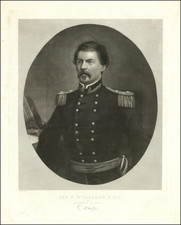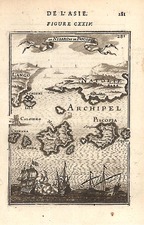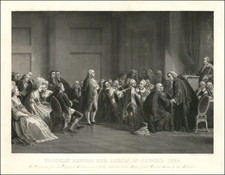This engraving depicts Blasius de Manfre, also known as Blasius Manfredi, a notable figure from Noto, Sicily, shown over half-length and standing to the right in front of a pillar. He is looking towards the front with his right hand resting on a parapet and is dressed in a collar with lace edging over a doublet. Above him to the left is a curtain. The background scene illustrates Manfredi performing his famous water-spouting trick on a stage in front of an audience of men. Props are seen on two benches behind him, and an angel with two trumpets flies above, with the sun emerging from the clouds. The entire scene is set within an oval frame within a rectangle, decorated with rosettes in the corners.
Blasius de Manfre, also known as Blasius Manfredi, was a 17th-century Maltese magician. Known for his ability to spout water, he was often depicted in this unique act. Wenceslaus Hollar, renowned for his detailed etchings and engravings, created this portrait based on an earlier print by Sebastian Jenet. Hollar's engravings are celebrated for their precision and artistic quality, often portraying notable figures and scenes of his time.
Wenceslaus Hollar, born on July 23, 1607, in Prague, was a prolific and accomplished Bohemian graphic artist of the 17th century.
Known to German speakers as Wenzel Hollar and to Czech speakers as Václav Hollar, he is celebrated for his masterful engravings and etchings. The turmoil of the Thirty Years' War, particularly the Sack of Prague, devastated Hollar's family, leading him to abandon his initial path towards a legal career and instead pursue the arts. His earliest surviving works date back to 1625 and 1626, showcasing the influence of Albrecht Dürer. In 1627, Hollar apprenticed under the esteemed engraver Matthäus Merian in Frankfurt, marking the beginning of his illustrious career.
During the early 1630s, Hollar resided in Strasbourg, Mainz, and Koblenz, capturing the essence of the Middle Rhine Valley through his depictions of towns, castles, and landscapes. In 1633, he moved to Cologne, where his talent began to attract significant attention. It was here, in 1636, that he caught the eye of Thomas Howard, the 21st Earl of Arundel, a renowned nobleman and art collector. Hollar joined Arundel on diplomatic missions to Vienna and Prague, and in 1637, he accompanied the Earl to England.
Upon settling in England, Hollar became part of Arundel's household, though he did not work exclusively for the Earl. He continued to create independently and for various authors and publishers. Following Arundel's death in 1646, Hollar commemorated him with a print designed by Cornelius Schut. Hollar's remarkable "View of Greenwich," published by Peter Stent, exemplified his early work in England and set a precedent for his meticulous and expansive cityscapes.
The English Civil War significantly impacted Hollar's career, although he remained productive. He withstood the siege of Basing House alongside royalist artists like Inigo Jones and William Faithorne. Despite the adversity, Hollar's output was prolific during this period, with numerous plates dated 1643 and 1644. Following his capture and subsequent escape during the siege of Basing House in 1645, Hollar relocated to Antwerp, where he reconnected with Arundel and produced some of his most acclaimed works, including cityscapes, seascapes, and intricate studies of nature.
In 1652, Hollar returned to London, continuing his work with notable publishers and illustrating various significant texts, including Ogilby's Virgil and Homer, Stapylton's Juvenal, and Dugdale's Warwickshire, St Paul's, and Monasticon.
Following the Great Fire of London in 1666, Hollar produced his famous "Views of London," capturing the city's devastation and subsequent rebuilding. In 1668, King Charles II commissioned him to document Tangier's town and forts. His return voyage included a notable naval engagement, which Hollar later etched for Ogilby's Africa. Hollar continued to produce well-regarded works until his death on March 25, 1677, in London, where he was buried at St Margaret's Church, Westminster.
Hollar's legacy endures through an extensive body of work, including some 400 drawings and 3000 etchings. His plates, numbering around 2740, encompass a vast array of subjects, from topographical views and portraits to intricate depictions of nature and architecture.
Collections of Hollar's work are held in prestigious institutions such as the British Museum, Windsor Castle, the National Gallery in Prague, and the Virginia Museum of Fine Arts. His contributions to graphic art are celebrated in catalogues by George Vertue, Gustav Parthey, and Richard Pennington, with a comprehensive catalogue published in the New Hollstein German series. Hollar's work remains accessible through digital collections, notably at the University of Toronto and the Folger Shakespeare Library.
The Wenceslaus Hollar Secondary School of Art in Prague honors his name, ensuring that his artistic legacy continues to inspire future generations.









![(California Photographs) [Group of 4 photographs of John H. Boden of Haywards, California, custom house broker in San Francisco]](https://storage.googleapis.com/raremaps/img/small/93197.jpg)


![[ Pictish Warrior Woman ] Feminae Pictae icon V](https://storage.googleapis.com/raremaps/img/small/99648.jpg)
![[Peter Martyr d'Anghiera] Petrus Martyr Tuscia te pepulit, Germania et Anglia souvit, Martijr que extinctum, nunc tegit Helvetia . . .](https://storage.googleapis.com/raremaps/img/small/86068.jpg)
